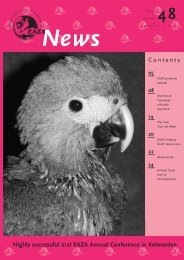EAZA Tiger Campaign extended to 2004 Contents - European ...
EAZA Tiger Campaign extended to 2004 Contents - European ...
EAZA Tiger Campaign extended to 2004 Contents - European ...
You also want an ePaper? Increase the reach of your titles
YUMPU automatically turns print PDFs into web optimized ePapers that Google loves.
‘Abu’, the elephant born after artificial insemination is already<br />
two years old and growing very fast and now weighs 810 kg.<br />
The Vienna elephants are kept <strong>to</strong>gether free, even during<br />
the night, only the adult bull is housed separately. Vienna’s<br />
philosophy of not chaining female elephants before birth<br />
again proved <strong>to</strong> be successful. During the birth of Abu,<br />
his mother female was separated in a box, but all other<br />
elephants could watch the birth directly. Tonga gave birth<br />
<strong>to</strong> Mongu <strong>to</strong>gether with Saby and Abu, the other females<br />
were only separated by a rope.<br />
Over the past five years the zoo has been involved in an<br />
extensive research programme dealing with social behaviour<br />
development of the Vienna elephant group, bioacoustical<br />
and chronobiological investigation. The Vienna Zoo is also<br />
engaged in in situ projects and supports and funds the<br />
AERP Programme of Cynthia Moss and Harvey Croze in<br />
Amboseli (Kenya).<br />
The Vienna elephant team also regularly conducts elephant<br />
management workshops and courses in Vienna, Thailand and<br />
Sri Lanka, training elephant keepers, veterinarians and cura<strong>to</strong>rs.<br />
Source: Harald M. Schwammer<br />
BORAS - SWEDEN<br />
’Shona’, a 13 year old African elephant cow (Loxodonta<br />
africana) gave birth <strong>to</strong> a healthy female calf at Borås<br />
Djurpark AB on 29 March 2003. The delivery happened<br />
quickly and everything went well. Shona has been behaving<br />
as a perfect mother from the beginning. This is the second<br />
elephant birth at Borås in 19 months so we are very proud<br />
of the breeding result. ‘Kwanza’, the first calf born in Borås<br />
is doing well and has been in the group since she was born.<br />
She is now a 500 kg package of energy.<br />
Source: Bo Kjellson<br />
Births and Hatchings<br />
Pho<strong>to</strong>: Almut Kimbacher<br />
APENHEUL - NETHERLANDS<br />
Apenheul acquired a number of wild-caught black howlers<br />
(Alouatta caraya) in the late 1980’s. Some went <strong>to</strong> other<br />
collections and a few died; by 1995, one male and two<br />
females remained. This trio made no attempts at reproduction,<br />
nor was there any reproduction when the male was<br />
changed, twice. Finally, a male from Port Lympne who arrived<br />
at Apenheul in 1999 did start breeding with the two wild-born<br />
females. However, none of the offspring survived. Then one of<br />
the two females died after an otherwise successful caesarian<br />
section. It was decided <strong>to</strong> hand-rear the male baby, as he<br />
was the only offspring of this wild born female. This went<br />
surprisingly well and he was successfully integrated back in<strong>to</strong><br />
the ‘group’ at about five months of age. Very soon afterwards<br />
the other female gave birth <strong>to</strong> a daughter, whom she<br />
proceeded <strong>to</strong> raise as if she had done nothing else all her life.<br />
Eight months later she gave birth again, but this offspring<br />
died. And again eight months later she gave birth <strong>to</strong> twins.<br />
There was some doubt about the survival potential of twin<br />
howlers. There was a twin howler (Alouatta pigra) birth in<br />
the USA that was raised successfully, and there have been<br />
reports of twins in the wild in Belize, which did not all make<br />
it. Apenheul decided <strong>to</strong> let nature take its course. They are<br />
now nearly half a year old and during this time have never<br />
required any attention other than their mother’s.<br />
Other notable recent births at Apenheul include a litter of<br />
2.2 yellow mongooses (Cynictis penicillata), 0.0.2<br />
red-bellied lemurs (Eulemur rubriventer), 1.0 Sclater’s<br />
lemur (Eulemur macaco flavifrons), 1.0.2 pied tamarins<br />
(Saguinus b. bicolor) [1.0 DNS], 0.1 brown woolly<br />
monkey (Lagothrix lagotricha), 0.1 white-cheeked gibbon<br />
(Hylobates leucogenys), 0.1 bonobo (Pan paniscus),<br />
and 1.0 Bornean orangutan (Pongo p. pygmaeus) [DNS].<br />
Source: Frank Rietkerk<br />
Pho<strong>to</strong>: Apenheul<br />
<strong>EAZA</strong> News 43 – 2003<br />
19<br />
July - August - September

















